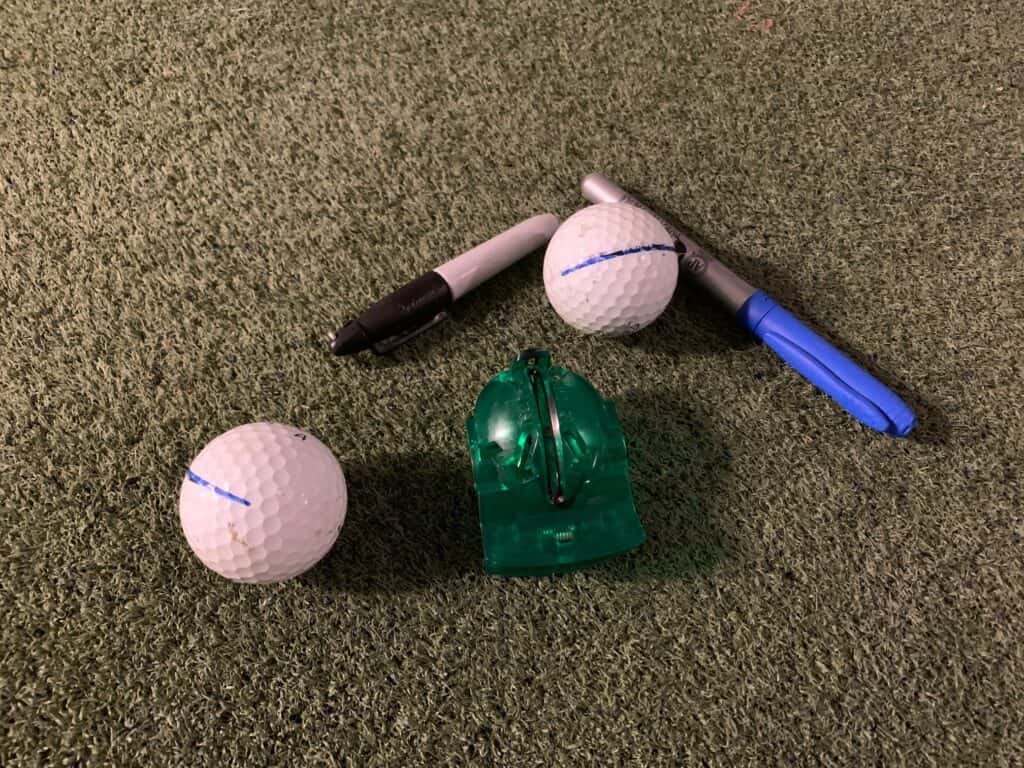The keys to making more putts on aerate greens:
- On putts inside of 10 feet, hit the putt with some extra speed.
- On putts inside of 10 feet, play a little less break.
- On longer lag putts, the goal should be to get it inside of a 3 foot circle.
- Keep your expectations realistic.
- Keep your putter face and golf ball clean.
Have you played a round of golf on aerated greens recently?
There aren’t things much worse in the game of golf than showing up at a course that has recently aerated their greens.
While this process is necessary to keep greens healthy and strong, it makes putting on these types of greens rather difficult. Most courses will aerate both in the spring and early fall.
So what is a golfer to do when faced with this situation.
Below I will take your through 5 steps I have used to make the most of the round of golf and keep your score from being destroyed by putting on greens with a bunch of holes in them that have been filled by sand!
How to putt on aerated greens?
Personal Experience: Patience is the key when putting on aerated greens. Sometimes you can hit the perfect putt and could miss by a foot or more. Make your read, line up and hit the best possible and learn to live with the results!

Tip #1: On putts inside of 10 feet, hit the putt with some extra speed
When faced with a putt inside of 10 feet, stick with your routine and read the green. From there line up your ball and ensure that you hit the ball with some additional speed than normal. Keeping in mind that the ball is not going to roll nicely and fall into the hole as the speed ends.
This is especially tricky on downhill putts, where on a normal green you would hit the ball just hard enough to have it die into the hole. Instead, we need to take some additional speed and putt more like Tiger Woods always did on those shorter putts, with the back the hole being the goal.
The golfer that normally hits these short putts firmly, will have less adjustments than the golfer that plays a higher, softer line and let’s the ball fall into the hole. If you are this second golfer, the additional speed is necessary to avoid the bumps along the way. When a putt is traveling faster it has a lower chance of being impacted by the bounces that will take place.
Related Post: How to make more putts (5 Tips)
Tip #2: On putts inside of 10 feet, play a little less break
Since you are playing the putt with some additional speed, this means you will need to play less break. The additional speed will not allow the putt to break as much as it might normally. In addition, the bumps that will occur from the greens being aerated will take away some of the break. Every time the ball bounces, the break in the putt gets reduced since the ball is in the air.
All you can do on the short putts inside of 10 feet is read the green, commit to a line and hit the ball firm. Do not beat yourself up for missed putts. Keep in mind that even on the PGA Tour, on perfect greens most weeks, the average make percentage from 8 feet is 50%.
Now take an amaetur, put them on aerated greens, the make percentage from 8 feet might be the 20% range.
Related Post: When to use a putter
Tip #3: On longer lag putts, the goal should be to get it inside of a 3 foot circle.
Anytime I have a longer putt of 20-30 feet, the goal is to have a rather simple tap in and if the ball happens to fall in the hole, great! At the end of the putt, I want a simple, stress free tap in and head to the next green.
When putting on aerated greens from 20-30 feet, a realistic goal is to hit the ball side of 3 feet and give yourself a chance. In order to make birdies or one putt pars, you will need to hit or chip the ball closer to the hole than 20-30 feet.
Prior to the round, make sure you head to the practice green and get a feel for the overall speed of the greens, especially in that 30 foot range. The speed will be different than normal and will more than likely be slower from the bumps that the golf ball will take on the way to the hole.
Related Post: How to make more short putts (5 Tips)
Tip #4: Keep your expectations realistic
When you head out to play a round of golf on aerated greens, the best gift you can give yourself is patience and acceptance. Being tough on yourself about not making putts on aerated greens is ridiculous. The way you putt on aerated greens is not a reflection of the type of putter you are.
One of the most difficult things about aerated greens is the variable of the bounces that take place throughout the putting. During a normal round on normal greens, you can make adjustments to the speed and how the ball is breaking that day. However, there is no feedback you can receive to build the skill and feel it takes to putt well that day.
Don’t overall analyze your putting after the round and start to lose confidence with your putting. Instead, put the round behind you, head to a course that hasn’t aerated their greens and work on those 5-10 footers and 30 foot lag putts! Remain confident and build up the feel on normal greens to prepare for your next round!
Related Post: What length putter should I use?
Tip #5: Keep your putter face and golf ball clean
One thing you must be aware of is the amount of sand that might be on your golf ball. Even if you have a 2 footer left, I would recommend marking it, cleaning it, and then hitting your putt. A clump of sand, even from 2 feet, could cause the ball to dive one way or the other significantly. Instead, take your time, clean the golf ball and make the putt.
You should also double check your putter face prior to hitting the ball that sand is not on the face of the putter. This interaction between a sandy face and the ball could cause directional and speed issues!
Related Post: Is a New Putter worth it?

BONUS TIP: Have Fun!
The bottom line during these rounds of golf is to ensure you have fun. Keep in mind that if you are playing a competitive round that everyone else is dealing with the same conditions. The golfer that can keep their mind right and remain patient might persevere at the end of the day. Keep your self talk positive, focus on the quality shots you are hitting and try to have fun!
While it can be frustrating, hopefully it only happens 1-2 times per year for you!
Related Post: What is a lag putt (Drills and Tips Included)
Take Action – What You Can Do Today to Get Better
What does this mean for you? I believe in the following recipe to get better:
1 – Improve your motion in the golf swing by identifying a golf instructor. Here are some options:
Here is a list of golf instructors that we have reviewed:
2 – Train to swing faster and improve your swing speed. Here are some options:
Looking to gain more Speed and Distance in your swing. Two Options:
3 – Understand course strategy and work to break through your next barrier. Here is a series on breaking through:
We have provided guides on how to break 100, 90, 80 and 70. Check out more below, if interested.
4 – Practice Frequently
Did you know that I build a golf simulator in my garage and have played over 500 rounds of golf on my SkyTrak system? It has been a game changer and one worth checking out. Here are some of my other posts on golf simulators frequently asked questions:
- Is a Golf Simulator Worth It?
- How to Build a Golf Simulator?
- What is the Best Golf Simulator?
- Golf Simulator Accessories?
- How to Build a Golf Simulator for under $7000
- Top 11 Reasons to Buy a SkyTrak
- How to Build a Golf Simulator for Under $1000
- Why Build A Golf Simulator?
- What Space is Needed?
- Can A Golf Simulator Improve My Game?
- How Much Does A Golf Simulator Cost?
- Don’t Forget to Check out our 15 best golf swings of all time.
I am an amateur golfer on a journey to get better, enjoy the game as often as possible and share my passion and knowledge with others. I have coached high school golfers at a high level and have a great passion for the game and want to give back. I enjoy learning about the golf swing and am currently studying to be a certified professional golf instructor. Join me in our journey to get better everyday.

